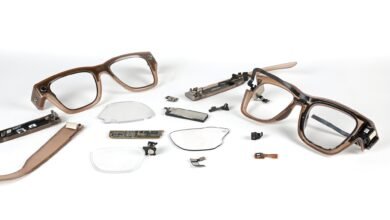Meta & Stanford Unveil Ultra-Thin XR Glasses with Holographic Display

▼ Summary
– Researchers from Meta Reality Labs and Stanford University developed a holographic display prototype that fits in standard glasses, combining ultra-thin waveguides and AI-driven algorithms for realistic 3D visuals.
– The device uses a custom waveguide and Spatial Light Modulator (SLM) to create full-resolution holographic light fields, differing from traditional stereoscopic XR headsets.
– It achieves a wide field-of-view and eyebox, allowing natural eye movement without losing focus, enhancing realism and immersion.
– Current limitations like the small étendue of SLMs have previously hindered the development of digital holographic displays with large FOV and eyebox.
– The project is part of a trilogy, with this prototype marking progress toward a commercial product that could pass a “Visual Turing Test” for indistinguishable digital and physical visuals.
Meta and Stanford researchers have developed groundbreaking ultra-thin XR glasses featuring holographic display technology, potentially revolutionizing how we experience virtual and mixed reality. The innovative design, detailed in a recent Nature Photonics publication, combines custom waveguide holography with AI-powered algorithms to produce lifelike 3D visuals in a sleek, glasses-sized form factor.
Unlike conventional augmented reality devices such as HoloLens or Magic Leap, this prototype uses a non-transparent waveguide system, classifying it as a mixed reality display. At just 3 millimeters thick, the optical stack includes a specialized waveguide and a Spatial Light Modulator (SLM) that manipulates light pixel by pixel, generating full-resolution holographic projections. This approach reconstructs the entire light field rather than relying on flat stereoscopic images, delivering depth and realism unmatched by current XR headsets.
Gordon Wetzstein, a Stanford electrical engineering professor involved in the project, emphasizes the advantages of holography: “It provides capabilities no other display can match, all in a package far more compact than existing solutions.” The system also addresses two critical challenges, wide field-of-view (FOV) and an expansive eyebox, ensuring the image remains sharp even as the user’s eyes move. This adaptability is key to creating a truly immersive experience while accommodating diverse facial structures.
One major hurdle in developing holographic displays has been the limited étendue, or space-bandwidth product, of current SLMs. A small étendue restricts both the FOV and eyebox size, making it difficult to balance visual immersion with practical usability. The team’s breakthrough lies in overcoming this constraint, paving the way for more natural and comfortable XR experiences.
This project marks the second phase of a three-part research initiative. Last year, Wetzstein’s team introduced the foundational waveguide technology. Now, with a functional prototype in hand, the focus shifts to refining the design for eventual commercialization, though widespread availability may still be years away.
Suyeon Choi, the paper’s lead author, describes the achievement as a “significant step” toward passing the Visual Turing Test, where digital projections become indistinguishable from real-world objects. The research aligns with Meta’s broader efforts in next-gen XR, including recent advancements in ultra-wide FOV headsets using reflective polarizers instead of waveguides.
While consumer-ready holographic glasses aren’t imminent, this development signals a promising future for lightweight, high-fidelity mixed reality wearables that could redefine digital interaction.
(Source: RoadtoVR)





